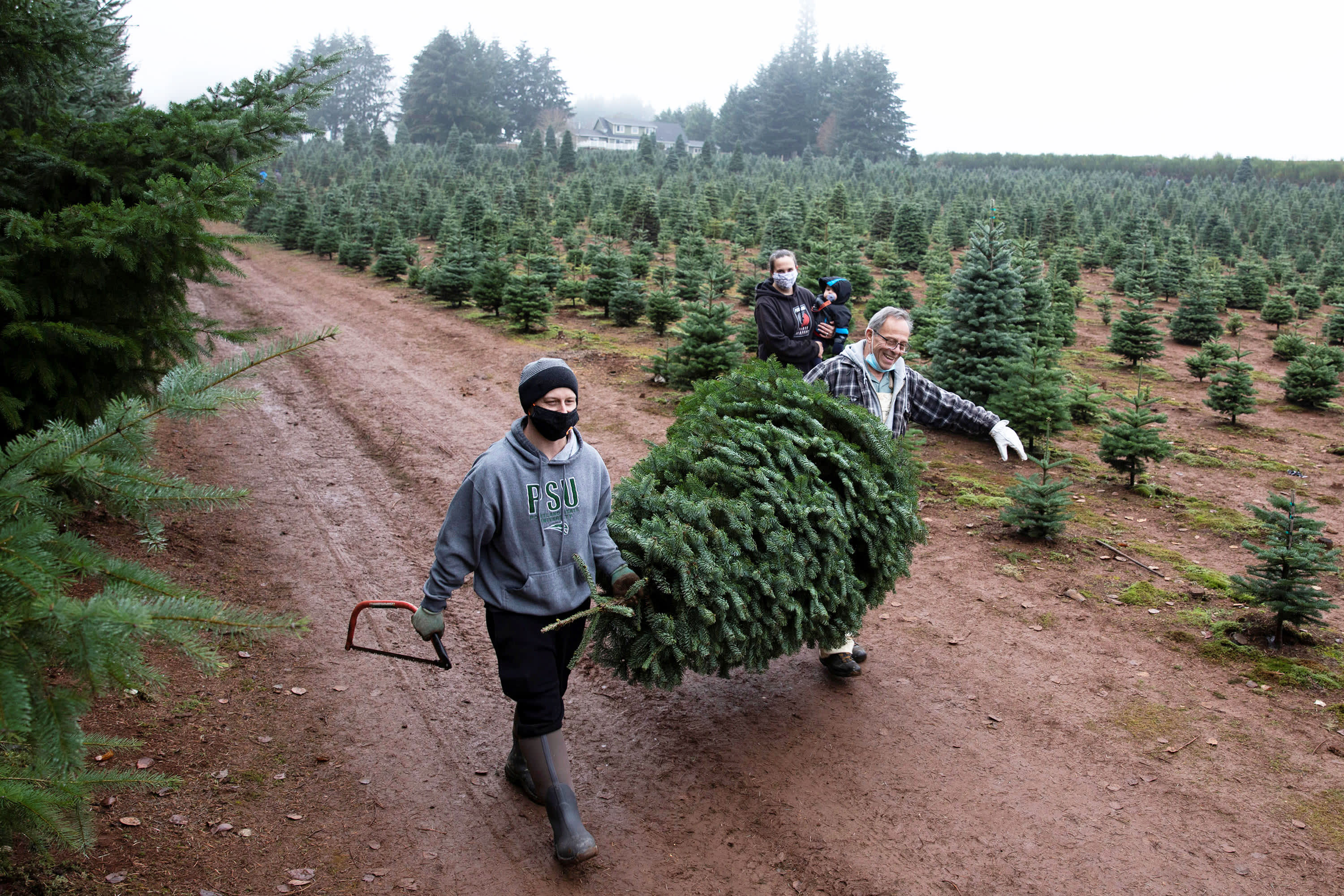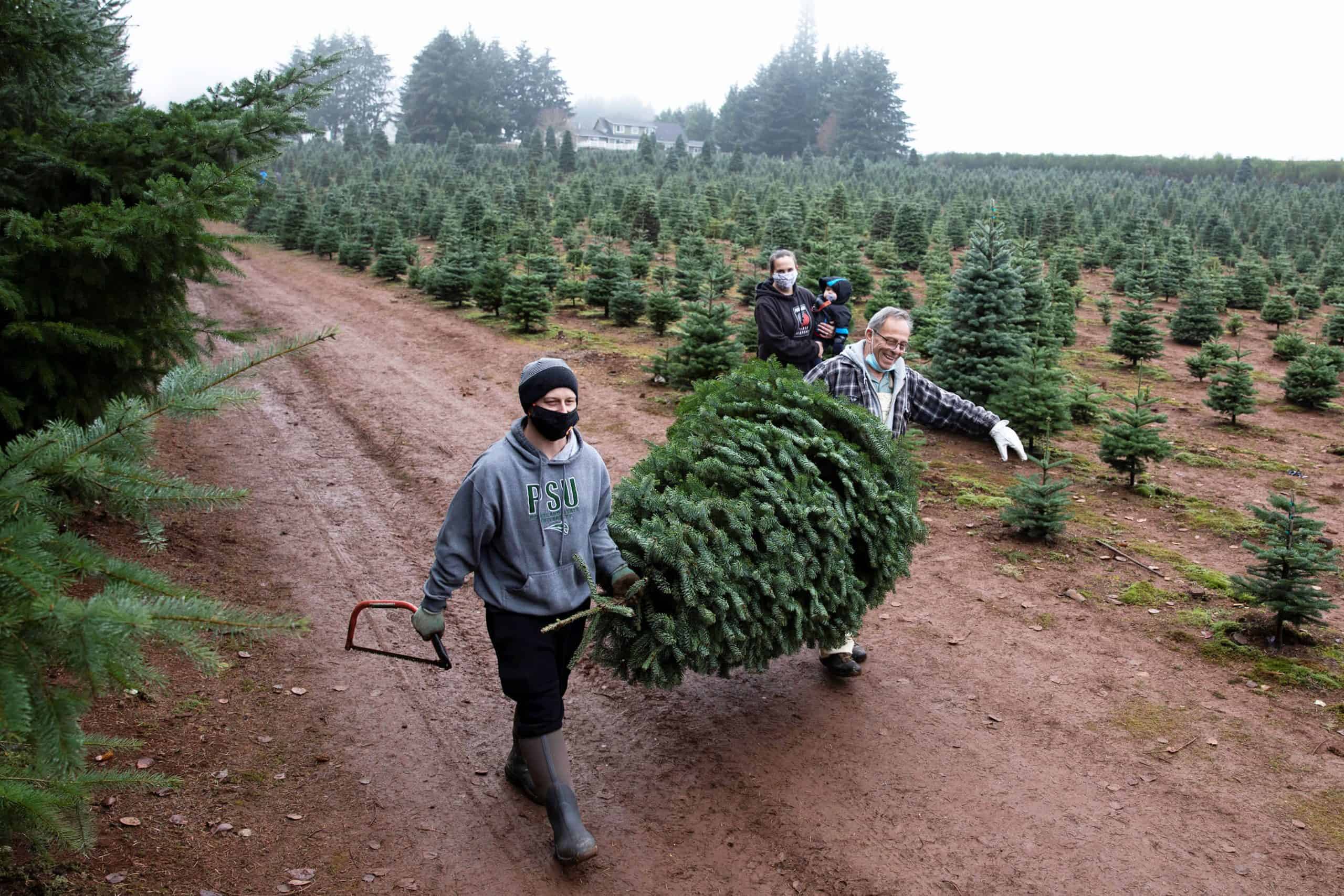
John Williams, left, and his dad Terry, right, both of Salem, carry a large Christmas Tree out of the field together at Tucker Tree Farm in Salem, Oregon, November 29, 2020.
Alisha Jucevic | Reuters
Tree retailers are having a spirited season this year, as Americans staying closer to home due to the coronavirus pandemic are turning the holiday spirit up a notch.
Traffic and sales this year at tree outlets have been anything but ho-ho-hum. Merchants are reporting a big season that started early and has continued to accelerate into the early part of December.
If consumers are planning on being Grinches this year, you certainly can’t tell it by tree activity.
“People have the time at home this year. They’re traveling less, of course, so they’re at home and they really want something to spark their mood because of the Covid stress that everybody’s under,” said Doug Hundley, seasonal spokesman for the National Christmas Tree Association. “The Christmas spirit is a big force this time of year, and people know that the more they put into it, the more they get out of it.”
Tree sales are up 29% so far in 2020, according to a survey of retailers done by Evercore ISI. There’s also evidence that people are getting larger trees and buying more home decorations.
The trend comes amid growing pessimism about the picture for the economy over the next three to six months. Wall Street forecasters are expecting little to no growth until a Covid vaccine comes online and Americans can get back to their normal lives.
Christmas trees are helping paint a bit more optimistic narrative.
“People are staying at home and getting a really big tree,” Evercore analyst Ed Hyman said in a note. “The theory is that people will buy additional wreaths, garlands, a larger tree when times are good, and avoid the extra purchase when times are tough.”
Indeed, each year Americans will buy between 25 million and 30 million real Christmas trees along with another 10 million to 20 million artificial ones, according to Statista. The $2 billion industry, though, can tell an economic story by how extravagant people are willing to get.
‘Just incredible demand’
The pandemic era has added a new wrinkle.
With new cases intensifying and the likelihood rising that yuletide celebrations this year will be more intimate and closer to home, that could benefit an industry that caters to just such an environment.
This year, folks have come out earlier to purchase the pivotal item for their holiday decor, and appear to be spending more on the accoutrements.
“We’re seeing a lot of enthusiasm, maybe a little increase in the size of trees that people select,” said Chris Gregory, owner of Boston Christmas Trees in Allston, Massachusetts. “What we have seen is an uptick in early sales, and a lot of families have bought a lot of other stuff to decorate their houses.”
Gregory said buyers are “very, very enthusiastic.”
That’s been the case throughout the industry.
Balsam Hill, a major tree retailer based in Redwood City, California, had a Christmas in July sale that saw huge demand – and it hasn’t slowed down since.
“What we’ve seen this year since the pandemic is just incredible demand for anything to make your home better,” said Balsam Hill founder and CEO Mac Harman, who called the July sale “crazy, just off the charts.”
“I’ve never had so many texts and messages and posts from friends about how they’re putting their tree up early,” he added. “People are going big, and they’re going early.”
As an economic indicator, Christmas trees can be a little tricky.
Economists refer to “inferior goods,” or ones that actually see higher demand when income falls. Christmas tree buying stayed steady during the last recession, from 2007-09, when 28.2 million trees were sold in each of the last two years of the Great Recession.
However, Harman said that back then, consumers bought smaller trees and fewer decorations.
He’s encouraged this time by people not turning to more inexpensive, smaller products, and their purchasing of tons of extras. He has noticed fewer big trees bought for offices, which makes sense as working from home remains prevalent.
“Consumer confidence is high, because we’re not seeing anyone trade down in price point at all,” he said. “That says people are optimistic and willing to make investments to make their home better.”


 Signal2forex.com - Best Forex robots and signals
Signal2forex.com - Best Forex robots and signals




